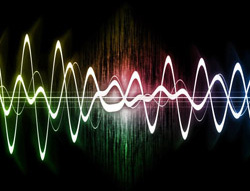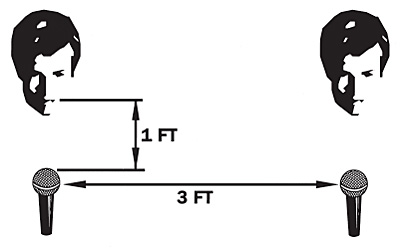
The 3-to-1 Rule
When it is necessary to use multiple microphones or to use microphones near reflective surfaces the resulting interference effects may be minimized by using the 3-to-1 rule.
For multiple microphones the rule states that the distance between microphones should be at least three times the distance from each microphone to its intended sound source. The sound picked up by the more distant microphone is then at least 12 dB less than the sound picked up by the closer one. This insures that the audible effects of comb filtering are reduced by at least that much.
For reflective surfaces, the microphone should be at least 1 and a 1/2 times as far from that surface as it is from its intended sound source. Again, this insures minimum audibility of interference effects.
Strictly speaking, the 3-to-1 rule is based on the behavior of omnidirectional microphones. It can be relaxed slightly if unidirectional microphones are used and they are aimed appropriately, but should still be regarded as a basic rule of thumb for worst case situations.
Potential Acoustic Gain Vs. Needed Acoustic Gain
The basic purpose of a sound reinforcement system is to deliver sufficient sound level to the audience so that they can hear and enjoy the performance throughout the listening area.
As mentioned earlier, the amount of reinforcement needed depends on the loudness of the instruments or performers themselves and the size and acoustic nature of the venue. This Needed Acoustic Gain (NAG) is the amplification factor necessary so that the furthest listeners can hear as if they were close enough to hear the performers directly.
To calculate NAG: NAG = 20 x log (Df/Dn)
Where: Df = distance from sound source to furthest listener
Dn = distance from sound source to nearest listener
log = logarithm to base 10
Note: the sound source may be a musical instrument, a vocalist or perhaps a loudspeaker.
The equation for NAG is based on the inverse-square law, which says that the sound level decreases by 6 dB each time the distance to the source doubles. For example, the sound level (without a sound system) at the first row of the audience (10 feet from the stage) might be a comfortable 85 dB. At the last row of the audience (80 feet from the stage) the level will be 18 dB less or 67 dB.
In this case the sound system needs to provide 18 dB of gain so that the last row can hear at the same level as the first row. The limitation in real-world sound systems is not how loud the system can get with a recorded sound source but rather how loud it can get with a microphone as its input. The maximum loudness is ultimately limited by acoustic feedback.
The amount of gain-before-feedback that a sound reinforcement system can provide may be estimated mathematically. This Potential Acoustic Gain involves the distances between sound system components, the number of open mics, and other variables. The system will be sufficient if the calculated Potential Acoustic Gain (PAG) is equal to or greater than the NAG. Here is an illustration showing the key distances:
The simplified PAG equation is:
PAG = 20 (log D1 – log D2 + log D0 – log Ds) -10 log NOM -6
Where: PAG = Potential Acoustic Gain (in dB)
Ds = distance from sound source to microphone
D0 = distance from sound source to listener
D1 = distance from microphone to loudspeaker
D2 = distance from loudspeaker to listener
NOM = the number of open microphones
-6 = a 6 dB feedback stability margin
log = logarithm to base 10
In order to make PAG as large as possible, that is, to provide the maximum gain-before-feedback, the following rules should be observed:
1) Place the microphone as close to the sound source as practical.
2) Keep the microphone as far away from the loudspeaker as practical.
3) Place the loudspeaker as close to the audience as practical.
4) Keep the number of microphones to a minimum.


